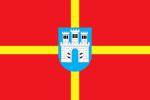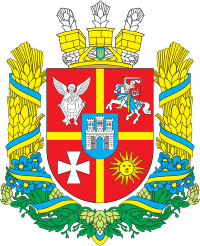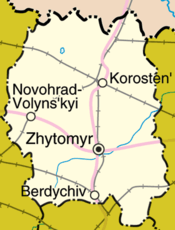Zhytomyr Oblast
Zhytomyr Oblast (Ukrainian: Житомирська область, translit. Zhytomyrs’ka oblast’; also referred to as Zhytomyrshchyna - Ukrainian: Житомирщина) is an oblast (province) of northern Ukraine. The administrative center of the oblast is the city of Zhytomyr. Its population is approximately 1,240,482 (2017 est.)[3].
Zhytomyr Oblast Житомирська область Zhytomyrs'ka oblast’ | |
|---|---|
 Flag  Coat of arms | |
| Nickname(s): Житомирщина (Zhytomyrshchyna) | |
 | |
| Coordinates: 50.65°N 28.52°E | |
| Country | |
| Administrative center | Zhytomyr |
| Government | |
| • Governor | Vitaliy Bunechko[1] |
| • Oblast council | 64[2] seats |
| • Chairperson | Volodymyr Shyrma |
| Area | |
| • Total | 29,832 km2 (11,518 sq mi) |
| Area rank | Ranked 5th |
| Population (January 1, 2017[3]) | |
| • Total | |
| • Rank | Ranked 16th |
| Time zone | UTC+2 (EET) |
| • Summer (DST) | UTC+3 (EEST) |
| Postal code | from 10 to 13 |
| Area code | +380-41 |
| ISO 3166 code | UA-18 |
| Raions | 23 |
| Cities (total) | 11 |
| • Regional cities | 5 |
| Urban-type settlements | 43 |
| Villages | 1625 |
| FIPS 10-4 | UP27 |
| Website | www |
_Zhitomir_Province%2C_Ukraine.jpg)
History
The oblast was created as part of the Ukrainian Soviet Socialist Republic on September 22, 1937 out of territories of Vinnytsia and Kiev oblasts as well as two border okrugs of Kiev Oblast – Korosten Okrug and Novohrad-Volynsky Okrug.
The oblast covers territories of the historic regions of Polesia, Volhynia, and Podolia, which are reflected on the oblast's coat of arms.
Before the 18th century bigger half of the oblast belonged to the Kiev (Kijow) Voivodeship, while smaller western half around the city of Zviahel (Novohrad-Volynskyi) belonged to the Volhynian (Wolyn) Voivodeship. Following the treaty of Andrusovo, the city of Zhytomyr (Zytomierz) continued to act as an administrative center of the Kiev Voivodeship.
Following the second partition of Poland, on the newly annexed territory was formed oversized Izyaslav Vice-royalty (namestnichestvo) which included former Polish territories in Volhynia, Podolia, and Kiev land and centered in Izyaslav. However a couple of years later the Russian Empire annexed more territories of the Polish Kingdom during the third partition of Poland contributing to the complete disappearance of the Polish statehood. The Izyaslav Vice-royalty was reformed and the territory of today's Zhytomyr Oblast predominantly ended up in the Russian Volhynian Governorate and the city of Zviahel which was renamed as Novohrad-Volynskyi (Novograd-Volynskiy) became its administrative center. Later the administrative center was transferred to the bigger city of Zhytomyr (Zhitomir).
Geography
The total area of Zhytomyr Oblast is 29,832 km2 (11,518 sq mi).
Among the points of interest it is important to mention the following sites that were nominated for the Seven Wonders of Ukraine:
- Church of Saint Basil the Great (Ovruch)
- Stone village state preserve
- Korolev Memorial Astronautical Museum
The Museum of Ukrainian home icons, which is the only one in Europe, is situated in Zhytomyr Oblast. It is located in Radomyshl, a small town, about 90 km (56 mi) away from Kiev. The museum is the part of the Radomysl Castle historical and cultural complex. It was founded by Olga Bogomolets.[4]
Population
The current estimated population of the oblast is 1,268,903 (as of 2013). Zhytomyr Oblast is the most important center of Polish minority in Ukraine, which is numbered there at 49,000.
Age structure
- 0-14 years: 15.8%

- 15-64 years: 68.1%

- 65 years and over: 16.1%

Median age
- total: 39.4 years

- male: 36.1 years

- female: 42.6 years

Economy
The economy of Zhytomyr Oblast mostly deals with mining of granite and other construction stone, forestry, agriculture and various machinery manufacturing.
The northern part of the province is highly affected by the Chernobyl disaster: some of the towns and raions are devastated and are included in the Chernobyl zone, while others are prohibited from producing their own agriculture.
Administrative divisions
Zhytomyr Oblast is subdivided into 23 raions (districts), and 5 of its cities are designated as separate raions within the oblast.
The districts of Zhytomyr oblast include:
- Andrushivka Raion (Ukrainian: Андрушівський район, translit. Andrushivs’kyi raion)
- Baranivka Raion (Ukrainian: Баранівський район, translit. Baranivs’kyi raion)
- Berdychiv City (Ukrainian: Бердичів)
- Berdychiv Raion (Ukrainian: Бердичівський район, translit. Berdychivs’kyi raion)
- Brusyliv Raion (Ukrainian: Брусилівський район, translit. Brusylivs’kyi raion)
- Cherniakhiv Raion (Ukrainian: Черняхівський район, translit. Cherniakhivs’kyi raion)
- Chudniv Raion (Ukrainian: Чуднівський район, translit. Chudnivs’kyi raion)
- Korosten City (Ukrainian: Коростень, translit. Korosten’)
- Korosten Raion (Ukrainian: Коростенський район, translit. Korostens’kyi raion)
- Korostyshiv Raion (Ukrainian: Коростишівський район, translit. Korostyshivs’kyi raion)
- Luhyny Raion (Ukrainian: Лугинський район, translit. Luhyns’kyi raion)
- Liubar Raion (Ukrainian: Любарський район, translit. Liubars’kyi raion)
- Malyn City (Ukrainian: Малин)
- Malyn Raion (Ukrainian: Малинський район, translit. Malyns’kyi raion)
- Narodychi Raion (Ukrainian: Народицький район, translit. Narodyts’kyi raion)
- Novohrad-Volynskyi City (Ukrainian: Новоград-Волинський, translit. Novohrad-Volyns’kyi)
- Novohrad-Volynskyi Raion (Ukrainian: Новоград-Волинський район, translit. Novohrad-Volyns’kyi raion)
- Olevsk Raion (Ukrainian: Олевський район, translit. Olevs’kyi raion)
- Ovruch Raion (Ukrainian: Овруцький район, translit. Ovruts’kyi raion)
- Popilnia Raion (Ukrainian: Попільнянський район, translit. Popil’nians’kyi raion)
- Pulyny Raion (Ukrainian: Пулинський район, translit. Pulins’kyi raion)
- Radomyshl Raion (Ukrainian: Радомишльський район, translit. Radomyshl’s’kyi raion)
- Romaniv Raion (Ukrainian: Романівський район, translit. Romanivs’kyi raion)
- Ruzhyn Raion (Ukrainian: Ружинський район, translit. Ruzhyns’kyi raion)
- Volodarsk-Volynskyi Raion (Ukrainian: Володарськ-Волинський район, translit. Volodars’ko-Volyns’kyi raion)
- Yemilchyne Raion (Ukrainian: Ємільчинський район, translit. Emil’chyns’kyi raion)
- Zhytomyr City (Ukrainian: Житомир)
- Zhytomyr Raion (Ukrainian: Житомирський район, translit. Zhytomyrs’kyi raion)
Nomenclature
Most of Ukraine's oblasts are named after their capital cities, officially referred to as "oblast centers" (Ukrainian: обласний центр, translit. oblasnyi tsentr). The name of each oblast is a relative adjective, formed by adding a feminine suffix to the name of respective center city: Zhytomyr is the center of the Zhytomyrs'ka oblast' (Zhytomyr Oblast). Most oblasts are also sometimes referred to in a feminine noun form, following the convention of traditional regional place names, ending with the suffix "-shchyna", as is the case with Zhytomyr Oblast, Zhytomyrshchyna.
References
- Volodymyr Zelenskyy introduced new Zhytomyr RSA Head Vitaliy Bunechko Office of the President of Ukraine (12 August 2019)
- Oblast Council website
- "Чисельність наявного населення України (Actual population of Ukraine)" (in Ukrainian). State Statistics Service of Ukraine. Retrieved 26 August 2017.
- Богомолець. О. "Замок-музей Радомисль на Шляху Королів Via Regia". — Київ, 2013
External links
| Wikimedia Commons has media related to Zhytomyr Oblast. |
